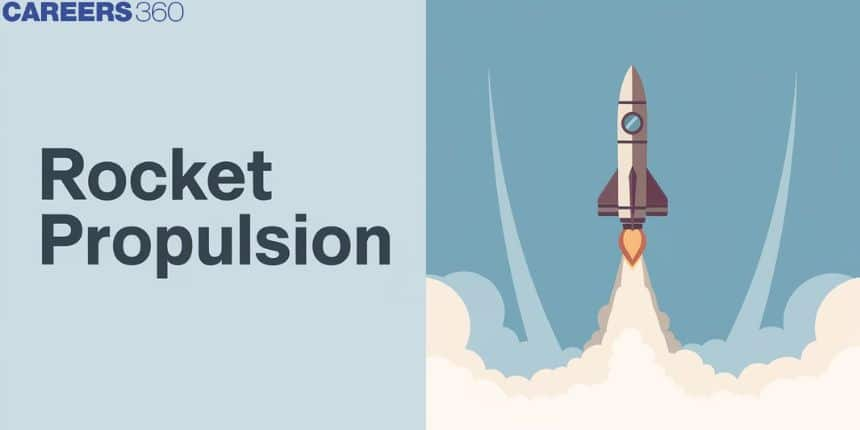Rocket Propulsion
The propulsion of a rocket is an example of momentum conservation. In a rocket, gases at high temperatures and pressure, are produced by the combustion of fuel. They escape with a large constant velocity through a nozzle. The large backward momentum of the gases imparts an equal forward momentum to the rocket. However, due to the decrease in the mass of the rocket fuel system, the acceleration of the rocket keeps on increasing.

This concept belongs to the laws of motion which is an important chapter in Class 11 physics. It is not only essential for board exams but also for competitive exams like the Joint Entrance Examination (JEE Main), National Eligibility Entrance Test (NEET), and other entrance exams such as SRMJEE, BITSAT, WBJEE, BCECE and more. Over the last ten years of the JEE Main exam (from 2013 to 2023), two questions have been asked on this concept. And for NEET no direct questions were asked from this concept.
What is Rocket Propulsion?
Let us assume a rocket of total initial mass (rocket + fuel) m0, starts moving upward due to the thrust force of the fuel jet. Assuming the velocity of the fuel jet with respect to the rocket to be u (assumed to be constant for this discussion) in a vertically downward direction and the mass of jet fuel emerging out of the rocket per unit time to be dmdt. Let the velocity of rocket after t time of motion be v and the acceleration of the rocket be a in vertically upward direction.

Thrust on the Rocket
F=−udmdt
Where F= Thrust
dmdt= rate of ejection of the fuel
u=velocity of exhaust gas with respect to rocket
m=mass of the rocket at time t
The net force on rocket-
Fnet =−udmdt−mg∗F=−udmdt[ if gravity neglected ]
Acceleration of Rocket (a)
a=−umdmdt−g
If g is neglected then
a=−umdmdt
Instantaneous Velocity of Rocket (v)
If g is neglected then-
a=−umdmdtdvdt=−umdmdt∫0vdv=−u∫m0m1mdm⇒v=uloge(m0m)v=u∗loge(m0m)=2.303u∗log10(m0m)
Burnt Speed of Rocket
It is the speed attained by the rocket when complete fuel gets burnt.
It is the maximum speed attained by the rocket
Formula
Vb=Vmax=uloge(m0mr)
Vb→ burnt speed
mr→ residual mass of empty container
Recommended Topic Video
Solved Example Based On Rocket Propulsion
Example 1: A rocket with a lift-off mass 3.5×104 kgis blasted upwards with an initial acceleration of 10 m/s2. Then the initial thrust of the blast is:
1) 3.5×105 N
2) 7.0×105 N
3) 14.0×105 N
4) 1.75×105 N
Solution:
Rocket Propulsion
dmdt= rate of ejection of the fuel
* Thrust on the rocket
F=−udmdt−mg
F= Thrust
∗F=−udmdt[ if gravity neglected ]
wherein
The negative sign indicates the direction of thrust is opposite to the direction of the gases.
Initial thrust = (Lift-off mass) $\times$ (a + g)
=(3.5×104)×(20)=7×105 N
Hence, the answer is option (2).
Example 2: A rocket of mass 1000 Kg set for vertical firing the exhaust speed is 200 m/s to give on initial acceleration of what will be the amount of gas ejected per second (in Kg/s ) to supply the needed thrust (g = 10 m/s )
1) 125
2) 100
3) 150
4) 75
Solution:

Acceleration of Rocket
a=umdmdt−ga=umdmdt [If g is neglected]
wherein
Instantaneous Velocity of Rocket
v=uloge(m0m)−gt
m∘→ Initial mass of Rocket
Force applied by the gases on the rocket =vdmdt
vdmdt−mg=madmdt=m(g+a)v=1000(10+15)200=125Kg/s
Hence, the answer is option (1).
Example 3: If the maximum possible exhaust velocity of a rocket is 2 Km/s, calculate the ratio m0mr for it to require the escape velocity of 11.2 km/s after starting from rest (approx) [ m0→ initial velocity, mr→ mass of emptied rocket]
1) 270
2) 300
3) 350
4) 200
Solution:
Given
Maximum relative velocity of fuel, u=2000m/s,
Escape velocity of rocket vb=11.2km/hr=11200m/s,
Neglecting the effect of gravity, the expression for the speed of rocket-
Vb=Vmax =uloge(m0mr)mr→ residual mass of empty container Vb=2.303ulog(m0mr)11.2=2.303×2×log10(m0mr)log10(m0mr)=11.22.303×2=2.432(m0m)=antilog(2.432)=270.4
Hence, the answer is the option (1).
Example 4: A spaceship in space sweeps stationary interplanetary dust. As a result, its mass increases at a rate dM(t)dt=bv2(t) where v(t) is its instantaneous velocity. The instantaneous acceleration of the satellite is:
1) −2bv3M(t)
2) −bv3M(t)
3) −bv3(t)
4) −bv32M(t)
Solution:
As given,
dM(t)dt=bv2(t)
As we know,
F=d(Mv)dt
So,
F=Mdvdt+vdMdtF=M(dvdt)+v(bv2)
We know that the net force is zero. F=0
dvdt=a=(−bv3M(t))
Where M(t) represents Mass as a function of times.
Hence, the answer is the option (2).
Example 5: The initial mass of the rocket is 1000 kg. Calculate at what rate the fuel should be burnt so that the rocket is given an acceleration of 20 ms-2. The gases come out at a relative speed of [Useg=10 m/s2]
1) 10Kgs−1
2) 60Kgs−1
3) 500Kgs−1
4) 6⋅0×102Kgs−1
Solution:
Minitial =1000 kga=20ms2Vrel =500ms

F−mg=maVrel dmdt−mg=ma(500)dmdt−1000×10=1000500(dmdt)=1000(30)⇒(dmdt)=60(kgs)
Hence, the answer is the option (2).
Summary
Rocket propulsion is the application of Newton's third law. It works on the principle of momentum conservation. In a rocket, gases at high temperatures and pressure, are produced by the combustion of fuel. They escape with a large constant velocity through a nozzle.